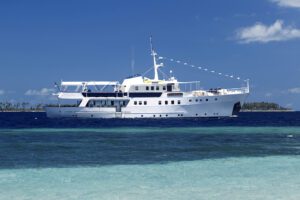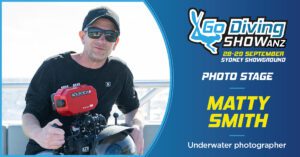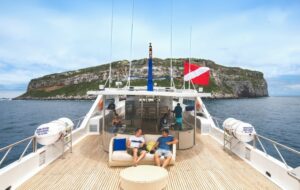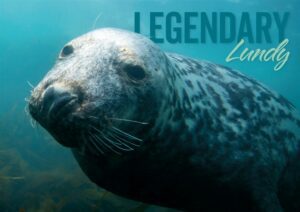Stefan Panis jumped at the chance to dive in a flooded Belgian mine that is normally closed off to divers.
Photographs by Stefan Panis.
At the end of 2020, the museum mine La Morépire in Bertrix, Belgium, was forced to close for touristic guided tours in the dry part of the mine. This gave owner Yves Crul some time to meet some people and to do some projects he normally didn’t had the time for. As I was working on a documenting project with the communities of Bertrix and Herbeumont, the major introduced me to Yves.
Yves is a super-enthusiastic person and mad about mines, especially slate mines. In a meeting we got the ‘go’ to come over and dive and document the mine during a short time window. It was made very clear from the start that this would be a unique, one-time-only opportunity to dive the site. I was very gratefull to do so, and with my team, the Mine Exploration Team, we made arrangements to start the project as soon as possible.
As a reward for the ability to dive there, we would have to make a 3D topographical map of the site, and present photographs and video to Yves for further use in the museum itself (which is now reopened – you can do a guided dry tour for €9.50 per person).
The mine is located in the Belgian province Luxembourg, in the Rue du Babinay, to be more precise. During our exploration, a jealous diver got word of our project, and posted false information on social media that everyone could dive there, in hope that the owner would get bored and stop the project… Luckily, he found out the truth soon enough!
Taking slate extraction to the next level
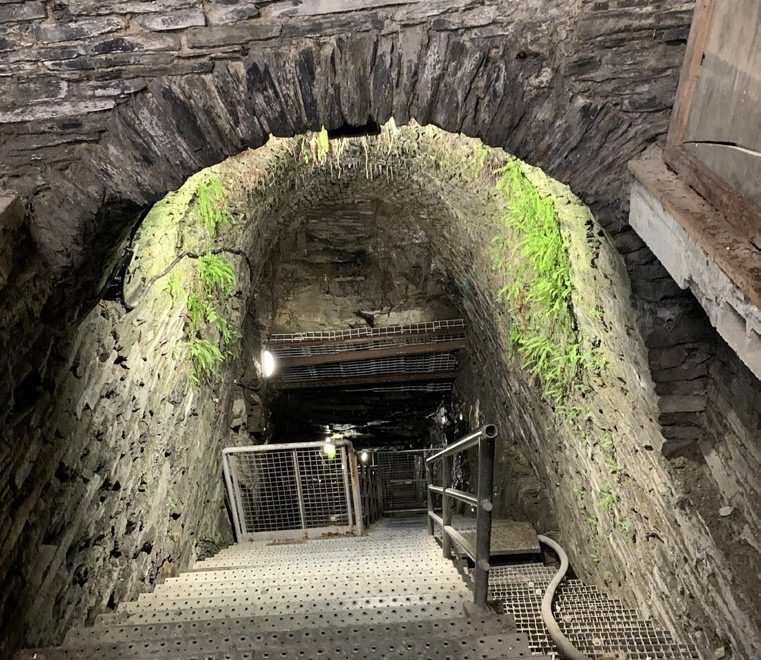
The history of the mine goes way beyond, but the era before 1836 is very vague… This date marks the selling of the mine to the Perlot family – a big name in the slate mine history, because the family owned several slate mine consessions through Belgium.
During the high days of the mine, they were extracting ‘ardoisière’, as the slate is called from three levels down the mine, with 70 employées working onsite. At the end of every day’s shift, a supervisor would inspect the next areas where some good slate would be, and holes were drilled to place the explosive charges. The last team would than set off the load, and the corridors were filled with dust, that had the time to settle until the next morning.
The blocks could be carved, and a man would carry the blocks with an average of 100kg on his back to the minecharts; When a cart was full, it was hauled out of the shaft by the winch operator, and once surfaced, in the different workshops the block was eventually turned into slate roof tiles. The workers were a special race, proud and stubborn! One time a worker had carved out an enormous block, which was actually too heavy to lift. But still he did, and because of over-forcing himself, the veins in his eyes burst and turned him blind… but he got up the block of 300kg – that’s how much it was worth to him…
In 1977, open air slate mines in Spain and Portugal could deliver much cheaper roof tiles, and eventually the mine was forced to close down, and the pumps were stopped. Slowly the ground water claimed back the mine, filling it to the top.
When Yves bought the mine in 1996, and started the Au coeur de l’Ardoise – ‘In the heart of the slate’ – he had to pump non-stop for five months to get the water partially out (the 25m level), and even today it is costing about €1,000 a month to keep pumping only this level…
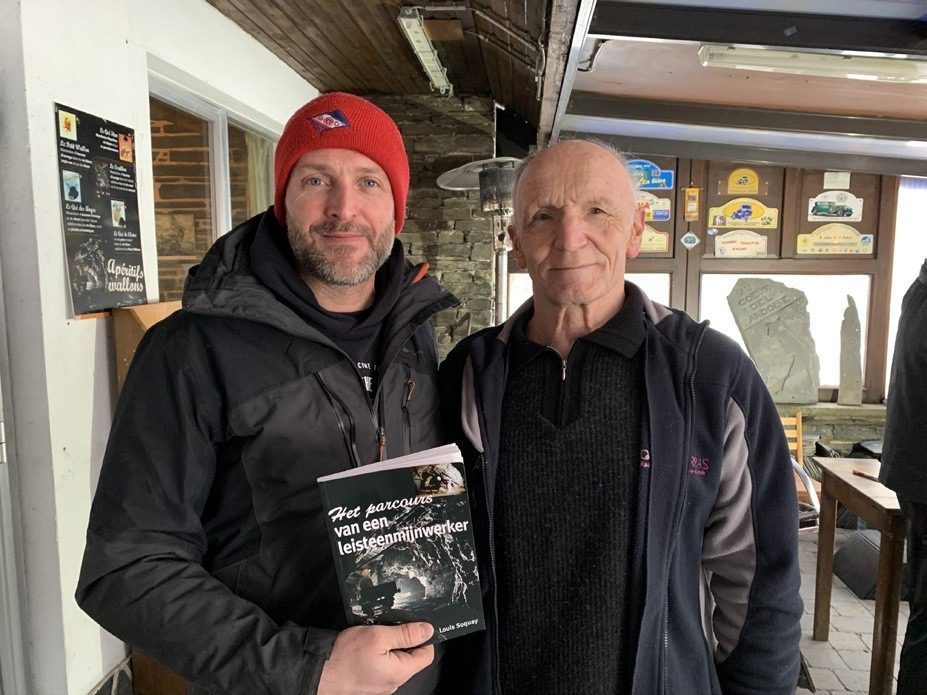
To go where no one has gone before
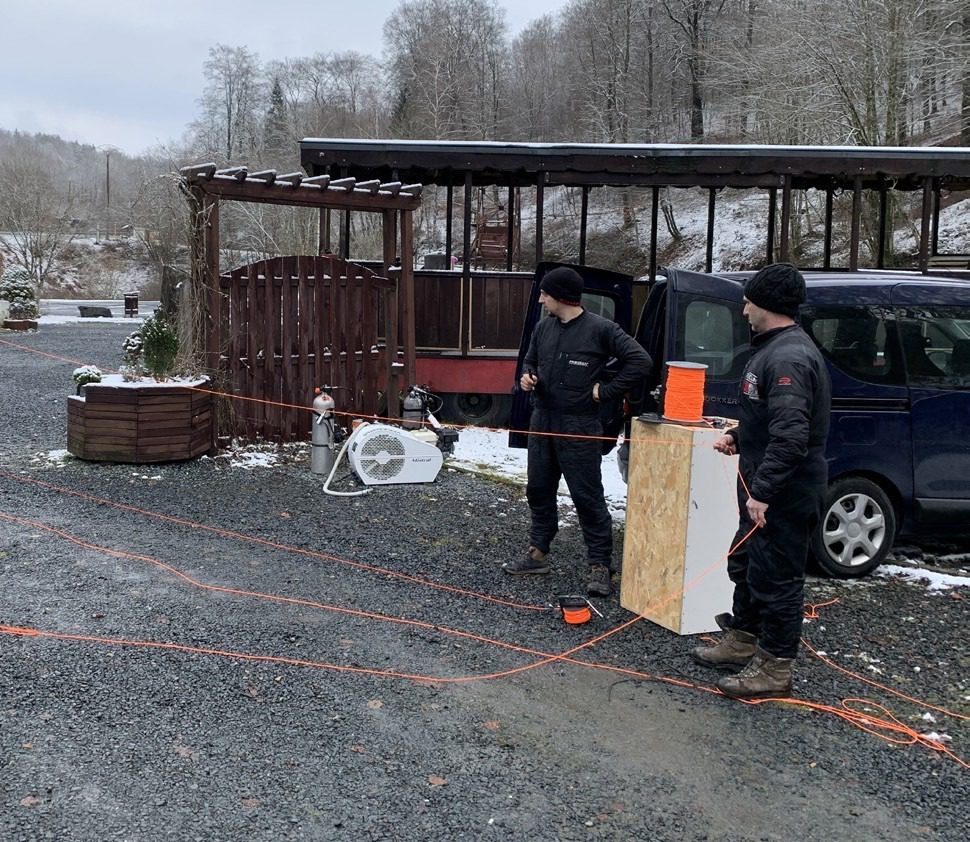
Every dive in a ‘new’ mine is special, but when official permission is granted and nobody has ever dived there before, that’s just amazing! Yves worked day and night, and in one week he was able to install a stainless-steel stairs (268 steps), and he could re-open the museum. The stairs come down all the way to the water and the shaft is wide enough to store stages, and cameras, so a luxury entry for us this time.
We entered the water down the main shaft, where a long time ago the mine carts were pulled in and out. It’s a mighty feeling, descending the shaft for the first time… At only 5m depth, we were facing side passages already both down the left and right sides. The right side where I can spot a beautiful old hand pump then split into a north and a south corridor.
At the end of the left corridor was an absolutely massive winch in wood, beautifully preserved, and giving access to a massive chamber, named the Italian room. Louis Soquay, the 80-year-old miner we met afterwards, gave us this information, because the Italian immigrants mainly worked in this part of the mine. At the top of the room is a gigantic wooden winch, amazingly intact! We dive down this 45 degree slope and find a mine cart still on the rails, a very impressive sight!
At the bottom of the room, the shaft narrows and continues to 37m, where it levels out, and turns underneath the main shaft to connect with a chamber from the right corridor at the 5m level. Due to the falling sediment and zero visibility, we named this shaft The Hellhole!
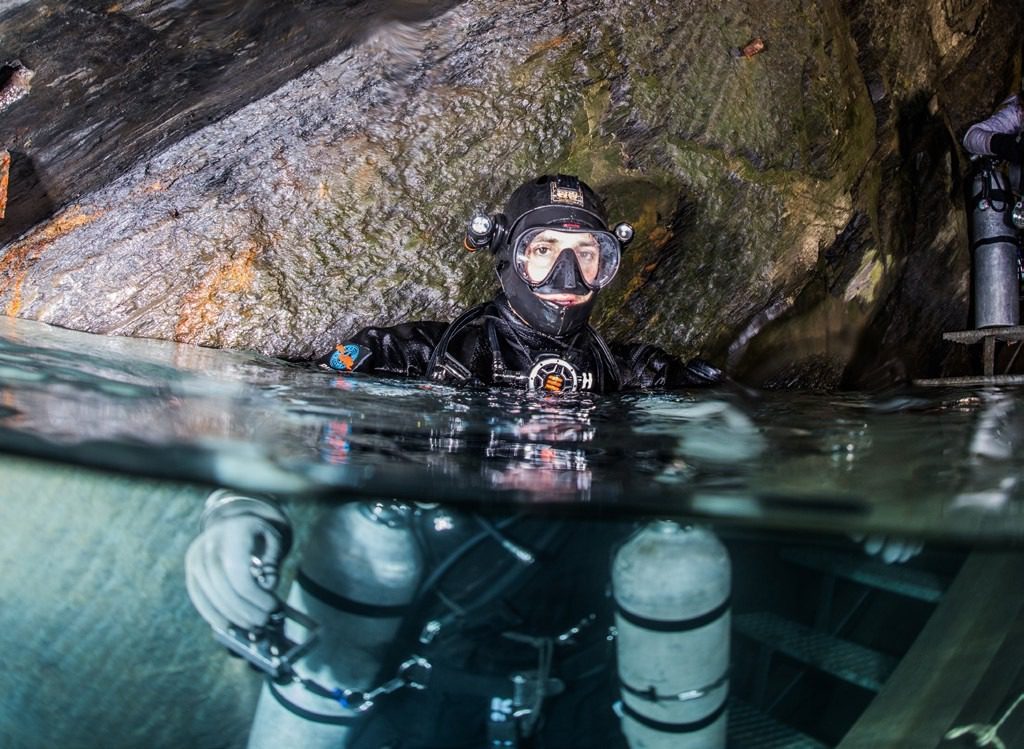
Unexpected company
In the left corridor 10m level, we discovered many objects, like an old phone to communicate with the surface. From the plans we knew that the first massive chamber couldn’t be far. Unfortunately the narrow passage was blocked, and it would have cost us too much precious time to clear the debris…
We moved further down the main corridor, and in a split second my heart skipped a few beats as my torch illuminated a face…! It turns out to be one of the decorative figures used in the museum that fell down here through a ventilation shaft.
Just ahead is a beautiful cart turn table that leads the way to the next extraction chamber, just awesome to float through this big room and admire the miners’ work.
At the next turn, we found beautiful steps, and surprisingly they took us to the surface! A perfect emergency exit for the team in the middle of the mine in case something would go wrong. Because of the distance, we started to use our scooters that Seacraft sponsored for the expedition to be able to cover more distance faster.
At the end we were faced with the completely collapsed corridor that sealed the last chamber forever.
Falling debris…
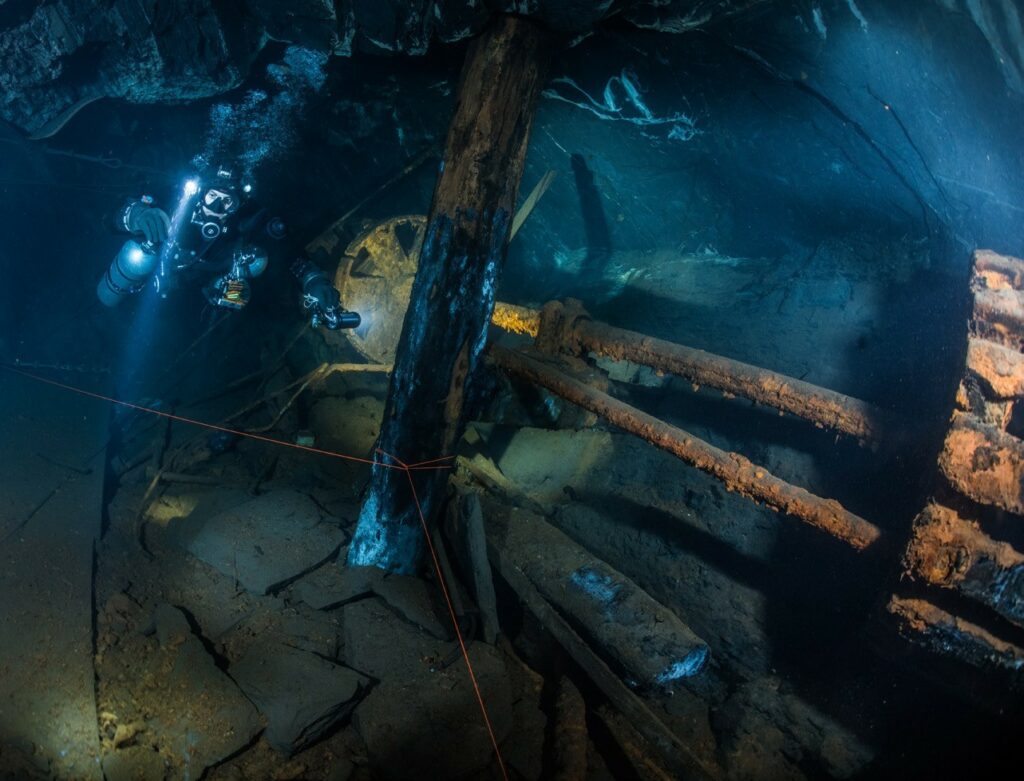
The 10m shaft at the right side held another nice surprise… At first, it’s full of debris. As this was the old part, it was probably used to stuff debris so they didn’t had to take it back up… we followed the double rails and just beyond the turn was another collapse, but as we were diving sidemount, we were able to squeeze through. We found a beautiful corridor which again led to a new room, where the top of the room came out in an air pocket, but with no connection to the upper dry levels.
The 60m level of the mine is much harder to proceed… We knew from Louis that also here the old right side was very instable, he told me he had never been in there as it was too dangerous. As David made the tie-off on the main lie, I was hanging in the corridor to let him lead the way when quite a slate block fell down from the ceiling on my legs, so we decided to take the new route!
At the base of the shaft lay a pile of old wooden ladders which made me wonder about the hard work the workers had to do, taking these ladders with a stone of about 100kg on their back… Again, our route was blocked, this time by a pile of electricity cables which created a dangerous spiderweb, so we decided to turn back and continue on another level. The next dive we took some tools to clear the path, and also discovered some extraction chambers, but unfortunately our time window to explore was short, so we were unable to complete the entire mine.
Measuring, measuring, measuring…
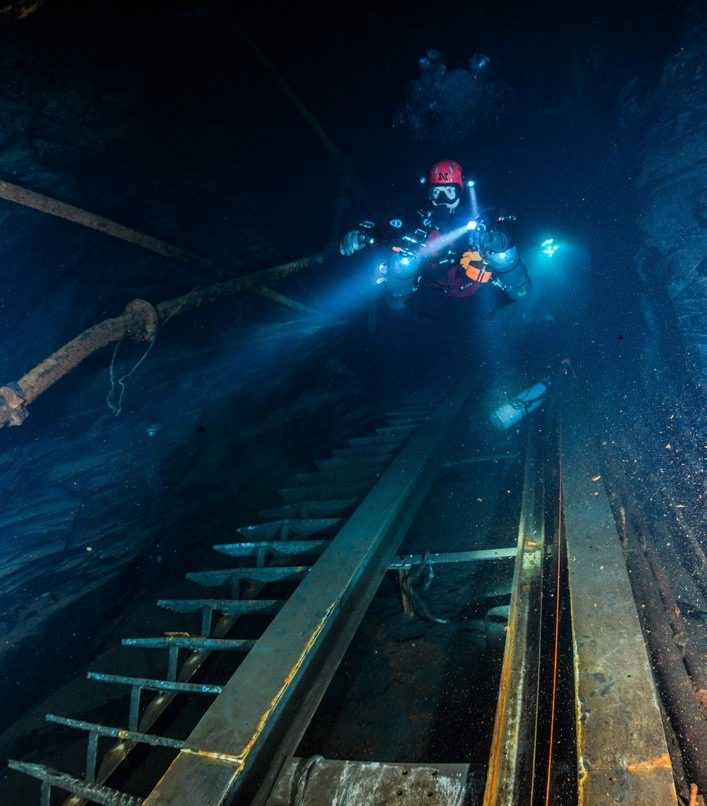
During the first dives a lot of line was put it, to make navigation easier and safer on the next dives. Besides that, Dirk needed a lot of information from the dive team to complete the topography. The main lines were marked every five metres, and here we took measurement, bearings and drew a sketch, and I took a still of every point plus some stills on ‘special’ subjects along the way. Next dive, Jimmy filmed it all completing the puzzle. It’s a job that takes time, but if it is done correct and precise, the results are amazing!
During the last dives we had a new tool to use, which proved to be very helpful and it will make the team’s progress faster in future projects – the Mnemo. The tool is connected on the line, and registers depth, distance angle and bearing. After the dive, the Mnemo can be logged to the computer and data can be transferred to an Excel file.
After the dives we were granted also permission to document the dry parts of the mine, both touristic and nontouristic – it turns out to be huge with some massive and spectacular chambers! It’s amazing how many tools we still found, like drills, hoses and hoists, but also personal stuff like a coat, gloves or an empty pack of cigarettes, a drinking can or a bottle of beer, which makes you wonder again about the ‘life’ under the ground…
The Morépire mine in 3D!
If you have a scientific approach on the project, some nice pictures or video is not enough, it has to be used to a final result. Dirk’s 3D-topography will be used as a new safety plan for the tourist parts, showing visitors escape routes, but it will also be used to mark points of interest during the mine-tour.
The realization is an incredible work as the mine is so big. At this point, Dirk is nearly ready with already over 200 hours of drawing work. The results are spectacular!
Envy and jealousy

During our project in the mine, we were lucky to meet some very interesting people, which led to new projects which are still ‘top-secret’. Sometimes the owner wants this to be handled quietly and modestly, but unfortunately sometimes you face jealous people too.
We had someone make a concerted effort to boycott us and the project, by posting fake news on social media that everybody could dive the mine just by calling the museum, probably thinking that by getting lots of calls, the owner would close down the project…
Luckily, both the owner and the major of the town could ID the guy, and he was reported to the officials.
At the moment of writing this article, the mine has reopened for public again, and unfortunately all diving activities have come to an end…

This article was originally published in Scuba Diver UK #74.
Subscribe digitally and read more great stories like this from anywhere in the world in a mobile-friendly format. Link to the article.



